Introduction to guide
Just like any other piece of outdoor hardware, Ariens Lawn Mowers are susceptible to damage from harsh environmental conditions every once in a while that can render the machine slightly faulty. In most cases these issues can be resolved with simple fixes, right from your garage so you don’t need to visit a service center. However, if you’re unfamiliar with working on power equipment, it is recommended that you enlist the help of someone qualified.
Prioritize your Safety!
Ensure that you read through all the safety precautions and instructions before you attempt to operate your mower – remember that it is a power tool with potentially hazardous parts that could cause serious injury.
- Ensure that you read and make yourself familiar with all the mower’s controls and switches, especially the emergency brake and levers
- Keep your hands and feet away from the machine’s rotating components at all times
- Never allow adults who are inexperienced with handling power tools like lawn mowers to operate the machine
- Spend some time clearing the area where you intend to use the mower of all foreign objects such as rocks and toys
- Ensure that there are no children or pets in the vicinity when you’re operating the mower
- The mower is not designed to carry passengers, never allow anyone to accompany you when operating the machine
- Avoid mowing in the reverse direction unless it’s really required
- Ensure that the discharge pipe is always facing a safe direction and not towards anyone or any obstruction like a wall as the debris may rebound
- Ensure that the grass catcher, chute and all other safety devices are in place before operating the mower
- Ensure that you slow the unit down sufficiently before making a turn
- Never leave the engine running when you have to leave the unit unattended. Ensure that you’ve removed the key from the ignition and turned off the parking brake
- Only operate the machine in broad daylight or under sufficient light
- It is highly recommended that you use eye protection when operating the mower
- Avoid mowing on wet grass as this severely decreases the tire’s traction
- Aim to mow up and down slopes when you have to mow on an incline, avoid mowing across the sloping surface
- Ensure that the mower is in gear when you’re going down a slope
Ariens Mower Troubleshooting
Similar to other big brands mowers, Ariens mowers may develop an error. We have put into the table most common errors and its solutions
Table 1. Ariens Mower Troubleshooting applicable for all models
| PROBLEM | POSSIBLE CAUSE | SOLUTON |
|
Engine not starting
|
Fuel has been used | Refill the fuel tank with fresh gasoline |
| Engine not been choked correctly | Refer to the engine manual to choke properly | |
| Engine has flooded | Wait for a while before starting the engine again | |
| Spark plug is faulty | Clean or replace the spark plug | |
| Fuel filter is dirty | Clean or replace the fuel filter | |
|
Difficulty starting engine
|
Fuel filter is dirty | Clean or replace the filter |
| Spark plug is faulty | Replace the spark plug | |
| Battery might have died | Recharge or replace the battery | |
| Fuel might be old and stale | Empty the tank and fill with fresh gasoline | |
| Wiring might be loose or damaged | Inspect and repair the wiring if necessary | |
|
Engine doesn’t turn over
|
The clutch pedal might not be activated | Press down the clutch with your foot |
| Attachment clutch may be left activated | Deactivate the attachment clutch | |
| Fuse might have blown | Replace any blown fuses | |
| Battery terminals may be dirty | Clean out the battery’s terminals | |
| Ignition switch may be damaged | Replace the ignition switch if required | |
| Solenoid or starter is damaged | Replace the solenoid if required | |
|
Engine loosing power
|
Grass height may be too high for deck | Increase the deck height |
| Cutting wet grass | Wait for the grass to completely dry | |
| Throttle must be in the incorrect choke mode | Adjsut the throttle as required | |
| Air filter might be dirty | Clean the air filter or replace it if necessary | |
| Water might have mixed with the fuel | Discard fuel and refill with fresh gasoline | |
| Air screen might be clogged or dirty | Clear out debris from the air screen | |
| Engine shuts off when in reverse | Reverse operation system has not been enabled | Turn the ignition key to enable reverse operation |
| Engine not turning off when operator leaves seat | Engine safety presence control is faulty | Check the circuitry and wiring for damage |
|
Headlights do not work
|
Light switch may not be turned on | Turn on the light switch |
| Bulb may have extinguished | Replace with a new bulb | |
| Wiring might be loose or damaged | Fix the wiring | |
| Fuse might have blown | Replace blown fuse | |
| Engine backfiring when turned off | Throtte speed not appropriately set | Set the throttle to the right speed |
|
Blades not rotating
|
Clutch system might be jammed | Remove the obstruction from the clutch |
| Drivebelt could have worn out | Fix the drive belt or replace it | |
| Blade mandrel might be bent | Relpace the mandrel or shaft | |
| Idler pulley may have frozen | Replace with a new pulley |
Ariens mower service and maintenance
Ariens mower will perform very well if operator performs all maintenance related activities within in the timeframes specified. We have created a special table describing tasks and intervals. Your mower will need to be taken to the service only if you don’t perform maintenance works or there is a specific issue you don’t feel comfortable with troubleshooting yourself.
Table 2. Maintenance works table applicable for all Ariens mower models
| Time Frame | Task |
|
Daily
|
Check brakes |
| Inspect tire presure | |
| Check the safety operator presence system’s functionality | |
| Inspect the fasteners for any loose fittings | |
|
Every 25 hours
|
Sharpen or replace the blades |
| Lubricate the necessary components as per the chart | |
| Check the battery level | |
| Clean out the battery terminals | |
| Inspect the transaxle coolant | |
| Change the engine oil | |
| Clean out the air screen | |
| Clear the engine’s air filter | |
|
Every 50 hours
|
Check the deck and mower height for adjustments |
| Change the engine’s oil filter | |
| Check the system’s muffler and spark arrestor | |
|
After 100 hours
|
Replace the spark plug |
| Inspect the v-belts and replace if necessary | |
| Clean out the cooling fins on the engine | |
| Replace the filter’s paper element | |
|
Each season
|
Replace the spark plug |
| Replace the filter’s paper element |
Operating the mower
It’s important that you familiarize yourself thoroughly with all the mower’s stickers and decals, learn what each of them mean and ensure that you identify their location on the unit before you attempt to begin mowing. Failure to get accustomed to these symbols can result in potentially serious injury.
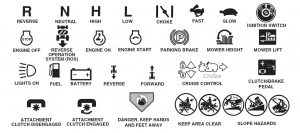
Attachment lift lever: This lever enables you to raise or lower the height of the mower, allowing you to attach or remove other components to your mower
Brake pedal: This pedal allows you to bring the mower to a stop and must be depressed when starting the engine
Parking brake: It locks the position of the brake and/or the clutch to ensure that the mower is securely held in place
Throttle/choke control: This lever is used to adjust the unit’s throttle response and controlling the engine’s speed
Attachment clutch lever: This lever enables you to activate the mower’s blades and enable various other attachments that may be connected to your mower
Ignition switch: This switch is used to start or to stop the engine
Reverse operation system: This control enables operation of the mower in the reverse direction
Light switch: This switch allows you to turn on or off the headlights
Motion control lever: This lever enables you to control the mower’s speed and direction of travel
Setting the parking brake: The mower has a built-in operator sensing function that enables the unit to detect the presence or absence of the user. So if you attempt to leave the seat before safely setting the parking brake, the engine will turn itself off as a safety precaution. In order to set the parking brake: – Press down the brake pedal completely and hold it there – Pull up the parking brake lever and hold it up until you release the brake pedal gradually – after this you may release the parking brake lever – Ensure that the unit is securely parked before leaving it
Halting the mower’s blades: It’s important that you ensure that you’ve stopped the blades before you leave the mower, do not walk away from the parked unit with the mower’s blades still running. In order to turn off the blades: – Ensure that the unit has been securely parked on a level surface – Identify the clutch control lever, this will be located near your foot or steering controls – Flick the switch to the ‘disengage’ position
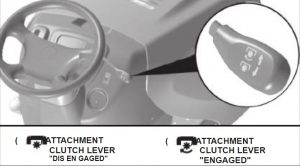
Stopping forward movement and the engine: – Gradually depress the brake pedal until it has been completely depressed – Move forward the main motion control lever to the neutral setting – Proceed to shift the throttle control to the fast setting
Achieving full throttle control: As far as possible, aim to operate the mower’s engine at the highest speed as this will improve your mowing efficiency and help you get a clean cut. – Operating at speeds below the full speed can lower your engine productivity – Push the throttle control lever to the max setting after you turn of the engine
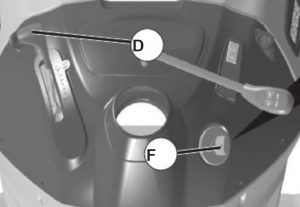
Figure: Throttle control is marked ‘D’ and ignition is marked ‘F’
Moving forward and backwards: You can use the motion control lever to move the mower in the forward or backward direction – Ensure that the lever is in the neutral position when you’re starting the mower – Gently release the parking brake – Move forward the motion control lever gradually to the desired position to achieve forward motion – You can move in the reverse direction by pulling the control lever in the opposite direction Avoid making sudden accelerations or decelerations as this may damage the engine.
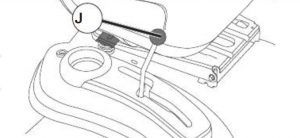
Figure: Motion control lever is marked ‘J’
Making adjustments and cleaning
You’ll need to recalibrate various parts of your mower from time to time in order to get the best mowing experience from your unit – parts such as the steering levers, brake levers, engine screen and filters will need to be cleaned or adjusted regularly. You can do this yourself but be careful when using a pressurized air blower.
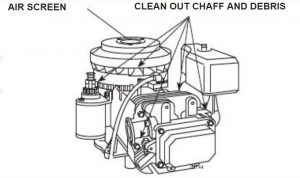
Ensure that you regularly clean out debris and chaff that can build up within the engine and around the air screen, including on the filter and oil tank’s cap. Spark plugs and mufflers must also be regularly washed to keep the engine’s airways clear of particles.
Installation of the mower unit:
– Ensure that the unit has been parked on a flat secure surface before you attempt to reinstall the mower, the main chassis must be at its lowest position
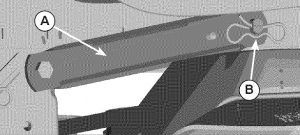
– Slide the mower beneath the unit and into position directly under the unit’s locks
– Attach the unit’s side facing suspension arms (A) to the main chassis with the help of the arm pins (B) located on the outside of the chassis.
– Proceed to now attach the rear facing lift links (C), don’t forget to secure the apparatus with the provided washer and spring (D)
– Carry out the same process of the other side of the tractor
– You can now attach the front link and work your way across the unit by inserting the rod part of the link’s assembly into the main hole and through the suspension bracket.
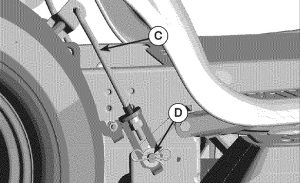
Adjusting the unit’s height and leveling the cutting deck: You may need to re-adjust the height and the deck’s leveling occasionally as they are likely to fall out of sync with regular use, especially over uneven or bumpy terrain. Before you begin working on these adjustments however, ensure that all the tires are filled to the recommended air pressure level and that the blade or blade shafts are in proper condition as any damage here can also affect the cutting pitch and angle.
– Raise the mower to the highest possible height setting
– Proceed to reposition the blade so that the tips of each cutting blade is facing the forward direction
– Take a note of the distance between the ground ahead and the tip of the blade
– If the front part of the blade is not in between 1/8 – ½’’ lower than the rear end of the tip you’ll need to adjust the height at the front end of the unit
– Proceed to do this by first loosening the but marked (A) in the figure before moving on the make the necessary adjustments to the nut B
– Use a wrench to make these adjustments and then raise or lower the height of the mower by making the necessary adjustments
Recheck all the measurements after you’ve adjusted the height to ensure that the mower uniformly balanced on all sides. It’s a good idea to try cutting for a short duration to check the effectiveness of the set height.